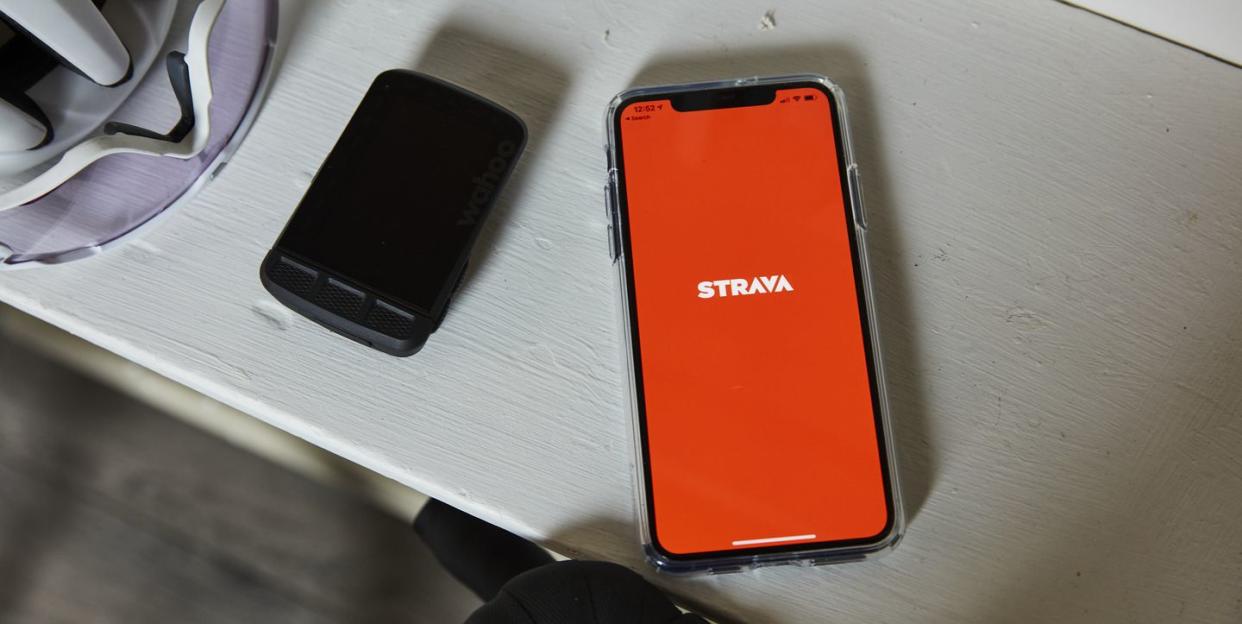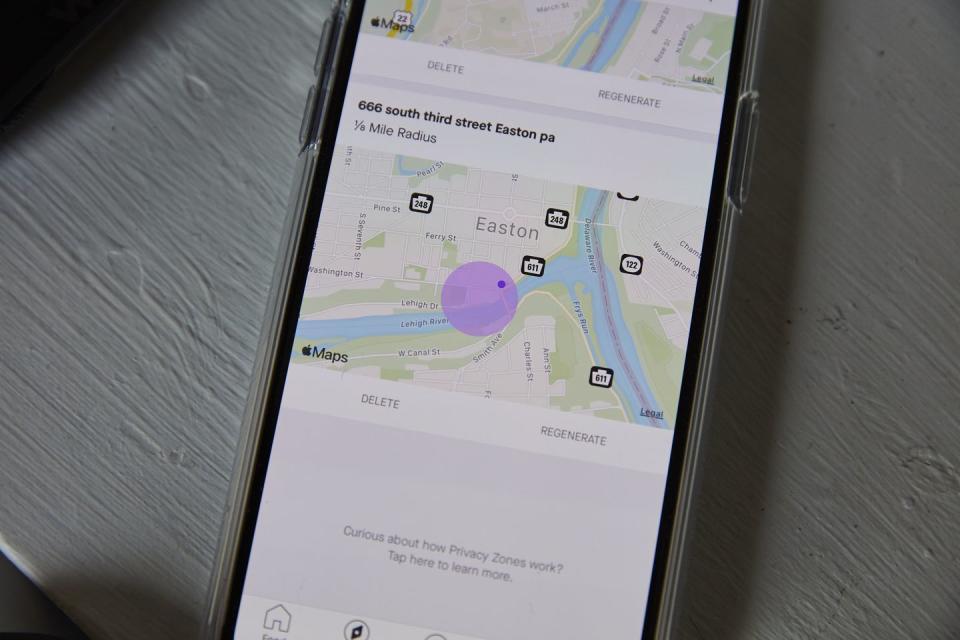Stay Safe With Our Guide to Strava's Privacy Controls

Strava is like Instagram for exercise—a social media space where you share your epic adventures, training rides, and everyday cycling and cross-training activities. Users love it so much they don’t want to ride without it, or as they say, “Strava or it didn’t happen.”
Problem is, unlike Instagram, TikTok, or other social sharing apps, it can be easy to unwittingly over-share on Strava, which has some worrying consequences for some people.
Such a case popped up last month when a U.K. runner went out for a solo jaunt only to come back and see that Strava had tagged a woman in his activity. When he clicked on her photo it showed her full name and map of her running route, which according to his Twitter post, “effectively shows where she lives.”
(1/2) Out running this morning on a new route and a lady runs past me.
Despite only passing, when I get home @Strava automatically tags her in my run. If I click on her face it shows her full name, picture and a map of her running route (which effectively shows where she lives) pic.twitter.com/flnHpSvA79— Andrew Seward (@MrAndrew) September 14, 2020
Some people faulted a feature called “Flyby,” a tool that’s been around for about five years that lets you see other users who you crossed paths with or who were also out riding or running near your route. You can playback your activity, as well as those on your “Flyby” on a map that pops up on your timeline when you upload your activity.
A fair number of folks, especially women, were unhappy with this Twitter revelation. So, a few weeks later, Strava disabled Flyby by default. You now had to choose whether or not you wanted to use this feature (and have others find you through it).
“As part of our ongoing commitment to privacy and safety, Flyby sharing will be default off unless athletes choose to change it. As always, private activities stay private, and we offer multiple privacy controls to ensure that athletes can have their intended experience,” a Strava spokesperson said in a statement sent to Bicycling.
Join Bicycling now for the latest advice and tips!
Reactions were mixed. Many users were unhappy, because they used this feature to find and follow other athletes in fun, harmless ways. Some of our own staffers said they liked using Flyby to stalk fast athletes in their neighborhood and see where they train. Others on Twitter said they liked Flyby for finding and connecting with other riders in their area who they otherwise may never have had a chance to interact with and meet.
With the feature turned off by default, user activities that would normally be teeming with other athletes suddenly became a virtual ghost town.
Not everyone was sad to see it go, however. As one woman tweeted:
Looks like Strava flybys has been disabled by default for all users - good honestly, as a woman it’s creepy as shit and I know men have used it more than once to find me when I didn’t want to be found
— Hannah 🚲 (@theeyecollector) October 15, 2020
Even before Strava turned Flyby off by default, you could still go into your controls and turn it—and other features—off in your Privacy Controls. But the problem remained that not everyone understands what all of Strava’s features actually are and/or how they work. They just plug and play.
Which brings another interesting twist to this tale: After the whole Flyby kerfuffle, it appears that the actual culprit in the case of the U.K. runners wasn’t Flyby at all, but another feature called Group Activities.
Group Activities is an automatic feature that detects if you recorded an activity at the same time as other users on the same route. But you don’t actually have to be riding side-by-side or in the same group to end up in someone’s activity. You just have to ride along the same segment long enough—that triggers the algorithm, and you end up with your profile picture on their Strava activity page as someone they shared the activity with. Not everyone loves that, either.
This isn’t the first time people have bumped into privacy issues with the fitness activity sharing app. There have been cases of stolen bikes that users suspected might have happened because thieves found them through their activities.
And in 2018, the Pentagon “severely restricted” fitness trackers and apps like Strava when Strava’s Global Heatmap feature—an anonymized, publicly available aggregation of workouts from millions of users—inadvertently revealed the locations of military bases around the world because soldiers were tracking their runs and activities using geolocation enabled devices and posting their activities.
None of this is Strava’s fault per se. It’s providing a service that over 70 million people use to upload literally billions of activities. But as we know from other social media apps, any tool that is that powerful and popular can also be misused and abused.
Here’s a look at what you should know about the settings Strava offers and how to use them to stay safe while you’re having fun. You will find these under your Privacy Controls, which is under Settings on the web and/or mobile app.
Check out and adjust the following features as you see fit. Note: Unless otherwise specified (as in the case of Flyby), Strava will use “Everyone” as your default setting. If you want it set otherwise, you need to make those changes in your Privacy Control settings.
Profile
This is the page that shows people who you are, the activities you do, and other biographical info including location, followers, photos, activities, stats, clubs, achievements, and gear like the bikes that you use.
You control the level of detail you include here. For instance, you can include just your state, instead of city and state. You can (and probably should) list your bikes by nicknames like “Hammerhead,” rather than Specialized S-Works Aethos. Heck, you don’t even have to use your real name or photo if you don’t want to.
You can set your profile to be public to “Everyone” or just “Followers.”
“Everyone” means all Strava users can see your complete profile details and activity summaries as well as follow you, and anyone on the internet can see your general profile stats and information if they search for you.
“Followers” means that Strava users you follow will see your page; Strava users who don’t follow you will see limited profile details, and random non-users on the internet will not see you at all. You can also approve who follows you.
Activities
This is the meat and potatoes of the app. Your activities are rides, races, workouts, etc. that you record or upload to Strava. That information includes the route (including a map) of where you rode, who you rode with, your ride stats, and your personal metrics like speed, time, and heart rate (which you can hide under “edit activity” if you choose).
You can set your activities to “Everyone,” “Followers,” or “Only You.” (You can also choose to make individual rides private, no matter what your default setting here.)
“Everyone” means just that. Everyone who uses the app can see your activities, and you’ll show up on leaderboards.
“Followers” means only your followers will see your activity details, and your activities will not appear on segment or challenge leaderboards.
“Only You” means your activities are private, are not on leaderboards, and only you can see them. If you’re participating in a Strava challenge, your followers may see updates on your progress.
Group Activities
This is where the definitions become a little fuzzy. If you didn’t read the description of this feature, you’d likely assume that Group Activities mean rides you’ve knowingly done with other people, like your Saturday morning shop ride or an event in which you participated. But that’s not how the algorithm works.
Instead, Strava will put you in another user’s group activity if you overlap with them for a certain amount of time… like the U.K. runner and the woman who popped up in his activity summary. Note: You can also opt to “Leave Group” by clicking on the little icon by their avatar on your summary page if you see this happen and aren’t happy about it.
You can set Group Activities to “Everyone” or “Followers.”
“Everyone” means that anyone on Strava can see you were part of a group activity (and you may unwittingly show up as part of a group activity you weren’t really aware you were a part of should you be riding along the same stretches of roads as a stranger.)
“Followers” means that you’ll only show up in the Group Activities of those you follow.
Flyby
This is the feature that raised flags recently. Flyby provides in-depth activity playbacks to anyone on Strava or the web. So anyone can watch your little avatar zip around the route you rode as well as those who were riding on similar roads or nearby at the time.
You can set Flyby to “Everyone” or “No One.” (As mentioned earlier, Strava now sets everyone’s settings to “No One” by default.)
“Everyone” means your rides are accessible to anyone on the internet using Flybys. Only your activities that are visible to everyone will be displayed here.
“No One” means your activities will not be visible on Flybys to you or anyone else.
Some users have taken to Twitter to request a “Followers” option here. Time will tell if they adjust the settings for this feature further down the line.
Privacy Zones
This one’s pretty important, especially since you likely routinely ride straight from your front door and back, creating thousands of activities that show people exactly where you live.
This feature allows you to enter an address or GPS coordinate and choose a radius around it that you would like to hide from other users. So you’ll see your activity start from 123 Where-I-Live Street, but no one else will.
You can set up multiple Privacy Zones from your workplace, friends’ houses, or anywhere that you typically start and stop your rides.

Finally, you can opt out of Strava’s Metro and Heatmap data collection. These features don’t reveal anything about your personal activity (though, as mentioned earlier, the military was less than thrilled to have so many troops sharing their activities here), but rather collect it in a database that is used by urban planners and transportation advocates to make their case for road features like bike lanes, and by other Strava users to discover routes and trails.
You can find everything you could possibly want to know about Strava and its privacy policies regarding user experience and data collection here.
You Might Also Like

